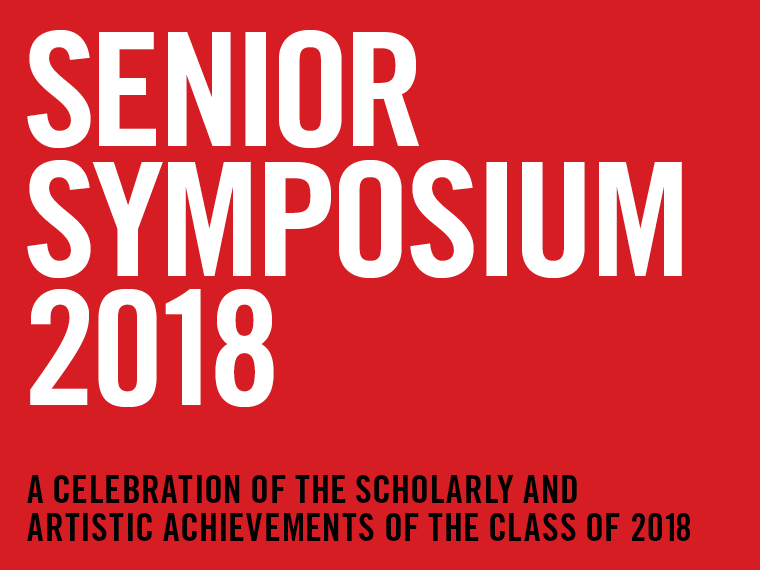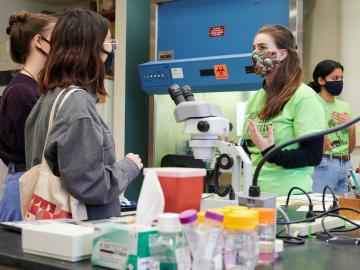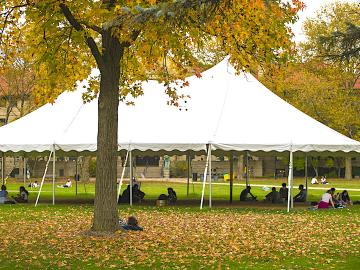Campus News
Senior Symposium 2018 Preview
April 25, 2018
Communications Staff

The Office of Undergraduate Research invites all members of the campus and community to celebrate the scholarly and artistic achievements of members of the Class of 2018, at the ninth annual Senior Symposium on Friday, April 27.
More than 90 seniors and fifth-years on 22 panels will each give a brief presentation about work they performed for honors, capstones, or research they conducted individually or with a faculty mentor. The symposium will examine a broad range of topics such as “Surviving Death: The Possibility of an Afterlife” and “The Language of Sport: Understanding Chile through Marathon Races and Fútbol Games.”
The symposium takes place in the King Building. Concurrent panels begin at 11:00 a.m., noon, 1:00, 2:00, 3:00, and 5:30 p.m. in various rooms. Assistant Professor of Computer Science Adam Eck and Yasmeen Musssard-Afcari ’18 will give a 4:30 p.m. keynote address on the topic of science and activism titled, “Creating Barriers to Determination of Structurally Cohesive Subgroups.” There will be a closing reception at 6:50 p.m. in the King Building second-floor lounge.
The following is a sampling of projects that will be presented on Friday.
Presenter: Naomi Roswell
“The Courage You're Looking For: Linking Academics to Community-Based Arts Programs in Oberlin”
At Oberlin, I have participated in and directed three community arts-based programs: Writers in the Schools, Girls in Motion, and Oberlin Drama at Grafton. Each program uses a unique and self-sustaining education model that produces creativity and knowledge and strengthens intra-community and community-college relationships. In this model, which I call a “cascade approach to learning,” an expert offers a workshop style course to students as an apprenticeship, who in turn develop and teach lesson plans for other students. Like water down a rocky slope, the knowledge and best practices passed down each step splashes back up in a new arrangement, invigorating the experts and providing immediate feedback and reflection. Through these programs, I am linked to dancers and writers in the middle school and actors in a men’s prison in a reciprocal learning-teaching dynamic. This talk will demonstrate how my classwork across the environmental studies, dance, creative writing, and education departments and my engagement in these three arts programs mutually ameliorated each other, while grounding my understanding of social justice and catapulting me into a life of community-based work.
Presenter: CJ Blair
“A Reconstruction of Emerald Ash Borer-induced Mortality in a Northeast Ohio Forest”
The Emerald Ash Borer (EAB) is an invasive beetle that has killed millions of American ash trees (Fraxinus spp.). Anecdotal evidence suggests that ash populations at Chance Creek Preserve in Lorain County died almost simultaneously following the rapid spread of beetles through this site. However, no research has determined a mortality date for these trees, and some trees show more advanced decay than others. Based on these observations, we hypothesize that differences in tree characteristics influence ash mortality, and we predicted that a chronology of ash growth would show variation in mortality dates. Between September 2017 and January 2018, we obtained cores from more than 200 dead ash trees throughout our 8-hectare study site. We measured the width of growth rings in all the cores to the nearest 0.001mm and developed a chronology of ash mortality dates using COFECHA software. We then obtained GPS coordinates for the ash trees and historic weather data for our site to explore correlates between ecological factors and ash mortality. Our results indicate that ash tree mortality spanned 1985 through 2012, with an exponential increase in mortality rate through the early 2000s. We also found that pre-2000 deaths coincided with increased temperature and major droughts, but mortality was not correlated with tree age or location. We therefore conclude that EAB reached Chance Creek Preserve between 2002 and 2003, and that prior deaths were climate-related, while subsequent deaths varied due to the growth of the EAB population over time.
Presenter: Anthony Dennis
“The Restricted Section: A Study of Chromatic Mediants and Their Effect on Film Music”
The purpose of this capstone project is to determine how film music signifies action, affect, and essence through a focus on music theory, embodied cognition, and music production. I will include a focus on the chromatic mediant, which is an altered chord based on either the mediant (the third of eight scale degrees) or the submediant (the sixth of eight scale degrees). Most successful film music depends on the chromatic mediant, whether it acts as to signify a hero’s journey, to create the soundscape for a horror film, or to create continuity in the repetition of musical gestures. I will also examine embodied cognition, which is a theoretical framework that explains human cognitive response to real world experience, and how it applies to sonic impact. I will conduct analyses of several approaches to film scoring. One includes “traditional” scoring, an approach mastered by John Williams. Hans Zimmer solidified “modern” scoring, another one of the approaches. I will also analyze the music of films including the Batman saga from Batman (Danny Elfman, 1989) to The Dark Knight Trilogy (Zimmer, James Newton Howard, 2005- 2012), the Harry Potter series (Williams, Alexandre Desplat, 2001-2011), and Inception (Zimmer, 2010). Additionally, I will personally score a scene to demonstrate practically how these approaches work to aid the director’s intention of the film and its potential effect on the viewer.
Tags:
You may also like…
Students Explore Oberlin’s Range of Research in This Year’s Lab Crawl
November 17, 2021
Lab Crawl was well attended this semester with many students making stops at demonstrations held in one or more of 22 labs across campus.
This Week in Photos: Alzheimer's Research
August 5, 2021
A picture of a student transferring an opaque substance into a gel box in a neuroscience lab serves as inspiration for this week’s photo series.
This Week in Photos: Campus Life on a Fall Day
October 28, 2020
There’s something magical in the air at Oberlin College on a fall day. The trees are filled with yellows, reds, and golds, and the crunch beneath your feet sounds like potato chips.


